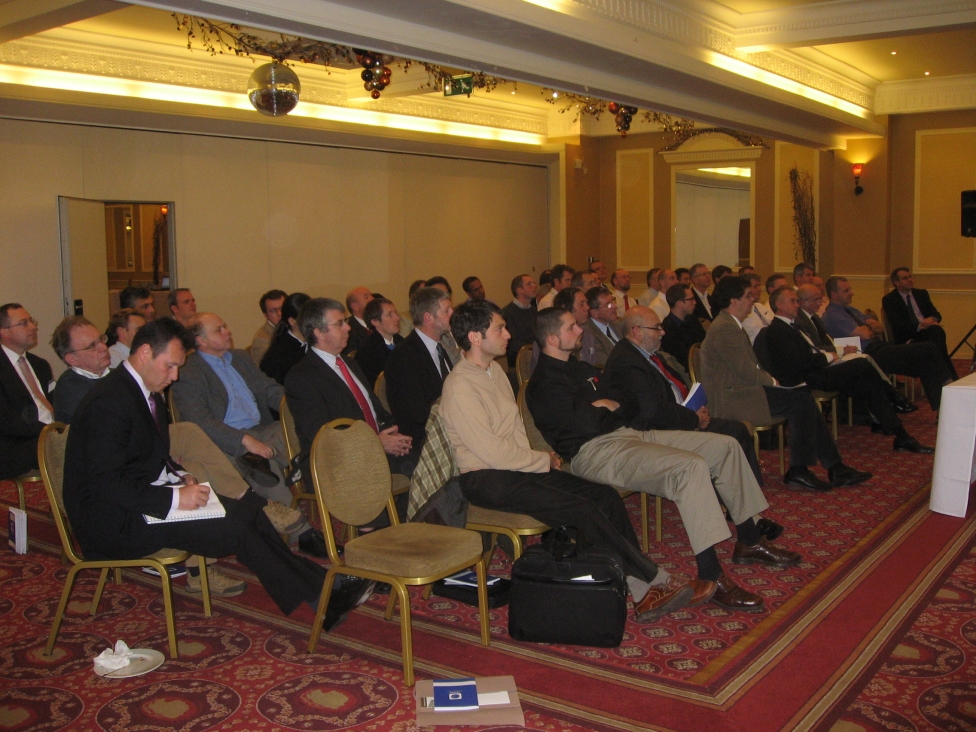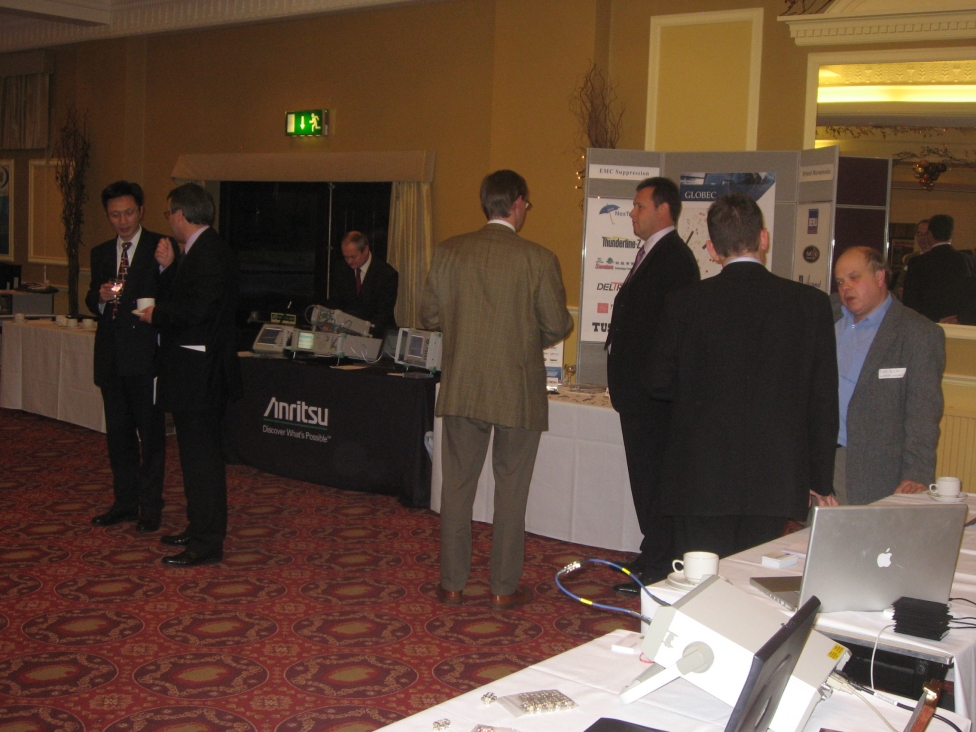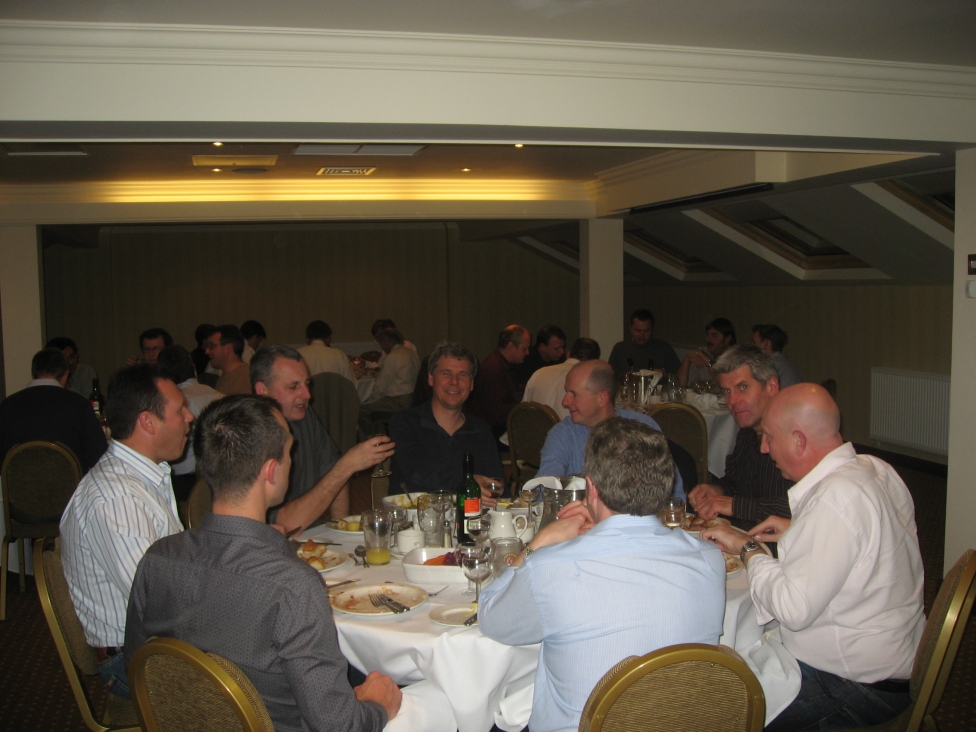 |  |  |
Rockingham Forest Hotel
(Formerly Hotel Elizabeth Rockingham)
Rockingham Road
Corby
Northamptonshire
NN17 1AE
| Tel | 01536 401348 |
| Fax | 01536 266383 |
| rockinghamforest@butterflyhotels.co.uk | |
| Web | http://www.butterflyhotels.co.uk/Our_Hotels/Corby/index.php |
Dominic FitzPatrick
Cardiff University
| Tel | 0781 444 0638 |
| dmfitzpatrick@theiet.org |
5 Gsps ADC Platform Concept for RF and Instrumentation Applications | |
| Francois Bor | |
| E2V | |
| In this paper we will introduce a 5Gsps ADC platform for RF and Instrumentation based on interleaving of fast ADC cores. Analogue digital converter is a known bottle-neck in the RF reception chain and is considered the keystone for accurate digital instrumentation. In order to process ever increasing bandwidth signals, there is a pressing demand for faster Analogue to Digital Converters , one popular solution to deal with this demand is the use of time domain interleaving, yet time domain interleaving requires many precautions or implies tremendous digital post-processing overhead. We will discuss the interest and limitations of time domain interleaving of ADCs to build a faster giga-sample ADC, we will also discuss the features needed on elementary ADCs to perform proper time domain interleaving: that is interleaving with yield results close enough to the one obtained from a non interleaved fast ADC so that no further digital post-processing is needed to make for imperfections of time domain interleaving. Based on this discussion we will explain how we have oriented e2v’s design to provide a 5 Gsps versatile ADC platform which will make things much easier for system designers. We will also explain our technological choices. Finally we will illustrate our discussion with results obtained on e2v quad 8 bit ADC in production and on next generation demonstrator. | |
| 5 Gsps ADC Platform Concept for RF and Instrumentation Applications | |
A Novel Broadband IQ Modulator / Demodulator MMIC | |
| John Birkbeck and Julian Trinder | |
| Roke Manor Research | |
| A broadband IQ modulator / demodulator MMIC will be presented, which uses a novel but conceptually simple closed loop approach to maintain performance over a broad bandwidth. Commercially available microwave IQ (de)modulator modules typically cover an instantaneous bandwidth of up to 2-octaves, for example 1GHz to 4GHz. This bandwidth is generally limited by the ability to maintain accurate 90? phasing in the local oscillator feed, due to practicalities of the means generated. Whilst this first implementation of the new technique targets a similar bandwidth, the underlying method is inherently broadband in nature. Measurement results made over an extended bandwidth will be presented, and possibilities for future exploitation outlined. | |
| A Novel Broadband IQ Modulator / Demodulator MMIC | |
An 18 to 40 GHz Double Balanced Mixer MMIC | |
| Liam Devlin and Andy Dearn | |
| Plextek | |
| This paper will describe a broadband, bi-directional mixer IC. The RF frequency range is 18 to 40GHz, the LO 20 to 42GHz and the IF 0.1 to 17 GHz. A double balanced passive topology is used to provide inherent isolation between all ports and good suppression of spurious outputs. On-chip RF and LO baluns are included to provide an interface between the single-ended ports of the MMIC and the differential signals required by the double balanced mixer. The IC was fabricated on the PP15-20, 0.15um gate length PHEMT process of WIN Semiconductor. With an LO drive of +10dBm the mixer has a measured conversion loss of between 7dB and 10dB, depending on frequency. LO to IF rejection is > 30dB. | |
| An 18 to 40 GHz Double Balanced Mixer MMIC | |
An introduction to ZigBee, its typical applications and certification | |
| Jon Harros | |
| Trac-KTL | |
| ZigBee is a low power wireless protocol, which uses the IEEE 802.15.4 radio specification for its physical and MAC layers. The current emphasis on energy efficiency and smart power usage has seen the rapid growth of the ZigBee technology within a diverse product range. With several products already on the market in the areas of home automation and smart metering, coupled with on-going development for the commercial building and telecommunication markets, this technology promises to offer design opportunities in a wide variety of applications. This paper covers the basic principles and structure behind ZigBee networks as well as current applications and certification issues. | |
Applications of Waveform Engineering for Analysing New Devices Technologies | |
| Chris Roff | |
| Cardiff University | |
| With increasing system demands calling for higher performance RF components there is a continual push towards new material systems and device topologies. As each new technology evolves new challenges are presented that must be faced in order to fabricate successful products. Most recently, GaN HFETs (Heterojunction Field Effect Transistors) have been in development as an enabler for solid state RF power amplifier applications at higher frequencies and power levels than afforded by incumbent technologies. In the course of the development of these devices, RF waveform measurement and active load-pull have been utilized at Cardiff University and QinetiQ Ltd. to explore device performance limitations and to help analyse and model the physically underlying mechanisms. This paper presents an overview of this effort, demonstrating how advanced RF measurements can help device technologists and circuit designers alike maximise the performance of developing technologies. | |
| Applications of Waveform Engineering for Analysing New Devices Technologies | |
Digital Phase Control Techniques for Accelerator Cavities | |
| Imran Tahir, Amos Dexter and Richard Carter | |
| Lancaster University | |
| RF cavities used for the acceleration and deflection of charged bunches of particles in high energy physics accelerators, medical linacs and synchrotron light sources need precise phasing with respect to the arrival of bunches and to each other. The paper describes phase locking and amplitude control performance achieved for 3.9 GHz superconducting cavities in the presence of microphonics using frequency division, digital phase detection with the HMC439QS16G and digital implementation of the controller. | |
| Digital Phase Control Techniques for Accelerator Cavities | |
Low Cost E-plane Filters with Advanced Performance Characteristics | |
| George Goussetis and Jia-Sheng Hong | |
| Heriot-Watt University | |
| In this paper we will present our recent advances in E-plane filters with advanced performance characteristics. In particular, we are proposing to different configurations, that produce size reduction and finite transmission zeros. E-plane triplet filters, can produce finite transmission zeros without any further fabrication complexity. The concept is based on simultaneous series and parallel coupling of the resonators in a triplet. A single triplet has been demonstrated to produce a finite transmission zero, which can be employed for sharp roll-off. Larger order filters are proposed to be fabricated as series cascade of triplets. E-plane filters with slow wave periodically loaded resonators have also been produced. The structure maintains the fabrication simplicity of all-metal split-block housing but the periodic loading with ridges can reduce the length of the resonator. Following a proof of concept filter with two resonators, a 5-resonator prototype filter has been successfully designed, fabricated and measured. Numerical techniques for the design of this type of filter will be presented. | |
| Low Cost E-plane Filters with Advanced Performance Characteristics | |
Memory Effect Modelling | |
| Andrew Wallace and Stephen Maas | |
| AWR | |
| In this presentation we discuss memory-effects of various classes and how these can be modelled using a system simulator. The methodology is based on using Volterra kernels from a number of harmonic balance simulations or measurements of the circuit under consideration, and transforming the kernels into discrete time-domain convolutions. The time-domain representation of the kernels enables a straightforward implementation in complex-envelope system simulator. Once the Volterra model has been constructed, the full power of the system simulator can be exploited to simulate the device under test using complex signals used to capture the statistics of arbitrary wide-band excitation, e.g. WCDMA signal readily available in the simulator | |
| Memory Effect Modelling | |
Production Assessment Methods for Anisotropic Conductive Film Bonding of Flat Panel Displays | |
| Nick Ridler, Martin Wickham et al | |
| NPL | |
| Two methods of electrical characterisation have been assessed for their suitability for production assessment of anisotropic conductive film (ACF) joints on Printed Circuit Boards (PCBs). Both flexible and rigid substrates with a range of differently bonded test samples have been investigated. The two electrical techniques were non-linearity measurements, which characterises the third harmonic voltage generated in the joint when a pure sinusoidal current is applied to it, and high frequency electromagnetic time-domain reflectometery (TDR), which assesses the reflections from the joint when stimulated by a signal containing a wide range of frequencies. The non-linearity measurements were shown to differentiate between well and poorly bonded samples with a greater degree of discrimination than DC resistance measurements. The high frequency electromagnetic TDR technique was not able to detect the effect of graduated bonding pressure on the performance of the bonds. | |
| Production Assessment Methods for Anisotropic Conductive Film Bonding of Flat Panel Displays | |
Revisiting the Doherty PA | |
| Steve Cripps | |
| Hywave | |
| The Doherty PA (DPA) has now reached high volume commercial implementation in the mobile communications sector, where it has allowed significant improvements in efficiency, combined with stringent linearity compliance. For example, 3G basestation PA modules are being shipped which have mean output powers in the 50 Watt range (300Watt PEP), which have mean efficiencies of 50% and can be predistorted to give ACP levels of -60dBc. Yet the DPA is still regarded as a \"quirky customer”, which can frequently display significant performance variations from unit to unit in production. This has motivated a new critical look at the basic DPA theory. Conventional DPA theory makes a starting assumption that the two active devices behave as ideal current sources. This paper will show that this condition will likely not apply when DPAs are designed using the existing theory. A new theory will be presented, which is able to predict most of the familiar \"quirks\" that are widely observed by DPA designers, and offers robust design strategies for eliminating the quirks in the design process, rather than in costly post-assembly alignment procedures. | |
| Revisiting the Doherty PA | |
Testing High Volume RF Devices | |
| Tim Masson | |
| Agilent | |
| Today most of us carry a Personal Communicator - maybe a simple (!) mobile phone or a more complex \'always-connected\' organizer. Whatever we call it a cellular telephone terminal has to be designed to meet exacting standards defined in the system specifications and policed by the regulatory authorities. However, some of parameters defined within the specifications cannot be economically achieved just by stringent design of the terminal equipment. Classically \'quality cannot be tested into a product\' but in reality equipment can meet the requirements only through calibration of the hardware. In mobile telephone manufacturing the processes of \'test\' and \'calibration\' become inextricably linked. In this paper the author draws from his theoretical knowledge and practical experience in the design of test systems to discuss some aspects of terminal test technologies and how these affect the economics of device manufacturing. | |
| Testing High Volume RF Devices | |
Ultra Low Noise Surface Acoustic Waves Oscillator for Instrumentation Market | |
| Michel Chomiki | |
| Temex | |
| The paper presents a new TEMEX product line of ULN (Ultra Low Noise) SAW (Surface Acoustic Wave) oscillators in the range from 300 to 600 MHz. At 500 MHz for instance, phase noise is as low as -165 dBc/Hz at 10 kHz offset and noise floor is better than - 178 dBc/Hz. TEMEX is developing two grades of packaging according to environmental conditions: Grade B for stabilized platform applications like instrumentation, radar simulator and ground and naval equipment, Grade D for airborne applications (package with inner shock absorbers). This paper is focusing on grade B for instrumentation market. After a short presentation of the performances of the oscillators, we will explain how we can obtain this kind of results with SAW technology. The paper will address the following topics: - Design of the oscillator: block diagram, oscillation conditions, description of each block, - SAW resonator: basics on SAW, design of the resonator, foundry process and specific packaging (all-quartz package) to achieve high Q, low g-sensitivity, low ageing and best in class flicker noise performances, flicker noise measurement test set-up, - Phase noise measurement and comparison with simulation using Lesson’s model, - Frequency fine tuning, - Comparison with Crystal oscillators, - Typical applications. | |
| Ultra Low Noise Surface Acoustic Waves Oscillator for Instrumentation Market | |
Using Handheld Devices to Survey the 2.4 GHz Band | |
| Adrian Wagstaff | |
| Mass Consultants Ltd. | |
| Conventional spectrum monitoring typically uses a measurement receiver and an antenna, which are calibrated and deployed according to a particular measurement procedure. This arrangement is hard to deploy in dense, urban environments. A research programme is currently being conducted, on behalf of Ofcom, to see whether small, handheld devices could be used to obtain useful statistics on the utilisation of the licence-exempt 2.4 GHz ISM band. Initial results are encouraging, with survey work having revealed interesting results in town and city centres. | |
| Using Handheld Devices to Survey the 2.4 GHz Band | |
"I Can See You!” - How Satellite Imagery Dictates the Need for Speed | |
| Keith Clarke | |
| SSTL | |
| This paper describes how the need for sub metre multispectral images has driven the requirements for faster data rates, high gain satellite antennas and antenna pointing mechanisms. The paper will discuss the system requirements, the resulting hardware and the uses to which such imagery is applied, both commercial and humanitarian. | |
| "I Can See You!” - How Satellite Imagery Dictates the Need for Speed | |
For exhibit enquiries please contact exhibition@armms.org
Contributions are invited with an emphasis on RF and microwave design, research, testing and associated subjects. An oral presentation will be made at the meeting and a written paper will be required for publication in the society digest, which is distributed to delegates at the meeting. Prospective speakers are requested to submit a title and a short abstract to the technical coordinator (see above) as soon as possible.
Click here to view our Guidelines for Authors
Click here to view our Publication Release Form